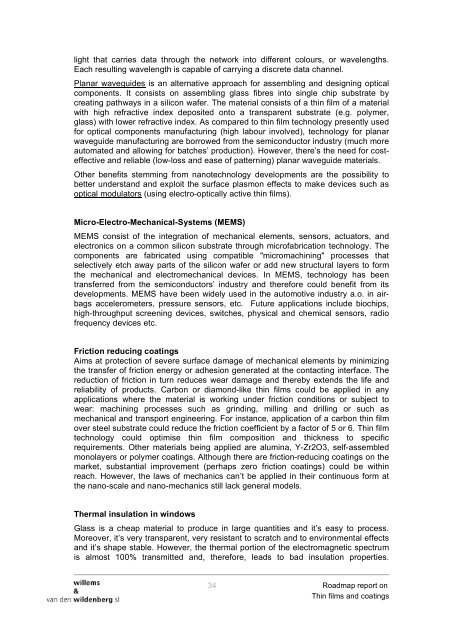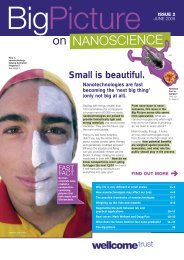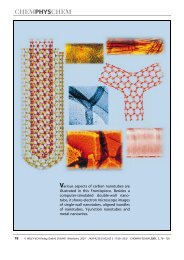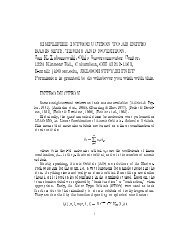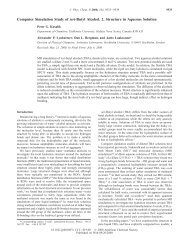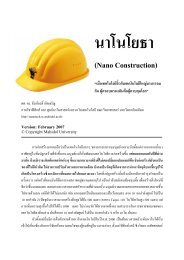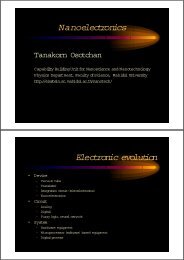'Thin films & coatings' Roadmap - Nano Mahidol
'Thin films & coatings' Roadmap - Nano Mahidol
'Thin films & coatings' Roadmap - Nano Mahidol
You also want an ePaper? Increase the reach of your titles
YUMPU automatically turns print PDFs into web optimized ePapers that Google loves.
light that carries data through the network into different colours, or wavelengths.<br />
Each resulting wavelength is capable of carrying a discrete data channel.<br />
Planar waveguides is an alternative approach for assembling and designing optical<br />
components. It consists on assembling glass fibres into single chip substrate by<br />
creating pathways in a silicon wafer. The material consists of a thin film of a material<br />
with high refractive index deposited onto a transparent substrate (e.g. polymer,<br />
glass) with lower refractive index. As compared to thin film technology presently used<br />
for optical components manufacturing (high labour involved), technology for planar<br />
waveguide manufacturing are borrowed from the semiconductor industry (much more<br />
automated and allowing for batches’ production). However, there’s the need for costeffective<br />
and reliable (low-loss and ease of patterning) planar waveguide materials.<br />
Other benefits stemming from nanotechnology developments are the possibility to<br />
better understand and exploit the surface plasmon effects to make devices such as<br />
optical modulators (using electro-optically active thin <strong>films</strong>).<br />
Micro-Electro-Mechanical-Systems (MEMS)<br />
MEMS consist of the integration of mechanical elements, sensors, actuators, and<br />
electronics on a common silicon substrate through microfabrication technology. The<br />
components are fabricated using compatible "micromachining" processes that<br />
selectively etch away parts of the silicon wafer or add new structural layers to form<br />
the mechanical and electromechanical devices. In MEMS, technology has been<br />
transferred from the semiconductors’ industry and therefore could benefit from its<br />
developments. MEMS have been widely used in the automotive industry a.o. in airbags<br />
accelerometers, pressure sensors, etc. Future applications include biochips,<br />
high-throughput screening devices, switches, physical and chemical sensors, radio<br />
frequency devices etc.<br />
Friction reducing coatings<br />
Aims at protection of severe surface damage of mechanical elements by minimizing<br />
the transfer of friction energy or adhesion generated at the contacting interface. The<br />
reduction of friction in turn reduces wear damage and thereby extends the life and<br />
reliability of products. Carbon or diamond-like thin <strong>films</strong> could be applied in any<br />
applications where the material is working under friction conditions or subject to<br />
wear: machining processes such as grinding, milling and drilling or such as<br />
mechanical and transport engineering. For instance, application of a carbon thin film<br />
over steel substrate could reduce the friction coefficient by a factor of 5 or 6. Thin film<br />
technology could optimise thin film composition and thickness to specific<br />
requirements. Other materials being applied are alumina, Y-Zr2O3, self-assembled<br />
monolayers or polymer coatings. Although there are friction-reducing coatings on the<br />
market, substantial improvement (perhaps zero friction coatings) could be within<br />
reach. However, the laws of mechanics can’t be applied in their continuous form at<br />
the nano-scale and nano-mechanics still lack general models.<br />
Thermal insulation in windows<br />
Glass is a cheap material to produce in large quantities and it’s easy to process.<br />
Moreover, it’s very transparent, very resistant to scratch and to environmental effects<br />
and it’s shape stable. However, the thermal portion of the electromagnetic spectrum<br />
is almost 100% transmitted and, therefore, leads to bad insulation properties.<br />
34 <strong>Roadmap</strong> report on<br />
Thin <strong>films</strong> and coatings


